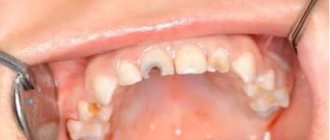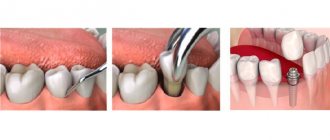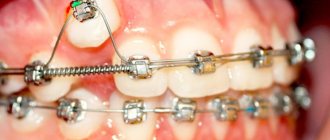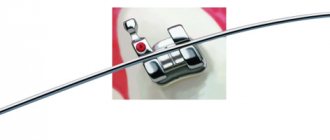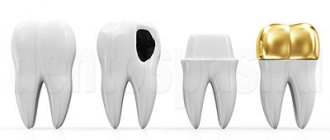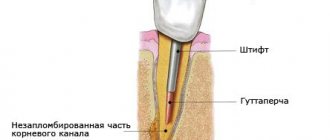958
The need for a crown may arise due to various factors. Most often, a severely damaged tooth requires restoration.
This problem cannot be solved with filling material. Even if the dentist completely restores the original shape of the tooth, it is impossible to restore its full functionality and correctly distribute chewing pressure in this way.
As a result, the unhealthy element of the dentition will be subjected to heavy loads and crack.
In most clinical cases, the crown is fixed on a pulpless tooth. But from the practical experience of doctors it follows that there are situations when a healthy unit with a living nerve is covered.
Optimal conditions for prosthetics
Depulpation in dentistry is the procedure for removing the neurovascular bundle (pulp) from the root canals.
This manipulation is performed before prosthetics, but is not always mandatory. The need for such a procedure is determined by the doctor after assessing the condition of the problem unit.
Prosthetics of a vital tooth is possible if the following indications are identified:
- The element is healthy, but its anatomical structure does not allow it to fully perform its functions (the tooth is excluded from the chewing process, or, on the contrary, it experiences excessive chewing load).
- Unaesthetic appearance due to any acquired or congenital anomaly.
- The enamel coating in a certain area is very sensitive and subject to rapid abrasion.
- There is a need to use a healthy organ as a support to secure the bridge.
Only with such indications is a decision made to preserve the neurovascular bundle. This allows you to fully preserve the nutrition of all tissues of the covered unit.
Depulpation is necessary if the crown will be fixed to a healthy element of the frontal section. All front teeth are single-rooted, and the nerves are located close to the surface, which means that when grinding it is easy to damage the pulp and cause tissue burns.
In multi-rooted teeth, the neurovascular bundle is located deep, and they can be left “alive”, since the likelihood of a burn is minimal.
Multi-rooted elements of the dentition may be left non-pulpless.
Let's figure out together which crowns are best placed on implants and why.
Come here if you are interested in the reasons for the appearance of blood from under the crown.
At this address https://www.vash-dentist.ru/protezirovanie/nesemnyie-p/koronki-np/shhel-mezhdu-desnoy-trebuet-terapii.html we will explain what to do when the gums have risen above the crown.
Is it possible to experience pain after implantation?
If the patient does not feel during the dental implantation procedure due to local or intraosseous anesthesia, is pain possible after the operation? A reasonable question for those who are afraid of facing pain. Contrary to popular belief, implantation is not a complicated operation at all, so many patients immediately go home after it, and the next day they go to work without experiencing any discomfort. However, this algorithm is applicable only after installing a small number of implants.
Some nuances
After depulpation, the tooth becomes fragile due to its “switching off” from the metabolic process. Excessive stress when eating food can also lead to premature loss. Due to these circumstances, prosthetics without depulpation has gained considerable popularity among patients.
The procedure itself is associated with certain difficulties. The main nuances of this process are:
- The need to use a large amount of water when grinding the tooth surface. This technique will protect the pulp from overheating (excessive heat exposure).
- Use of a special tip.
- Use only new bur in the work. If the cutting part of the bur has already been used before, difficulties arise when grinding down the dentin, which will lead to rapid heating of the nerves, and as a result, their death.
- Upon completion of the procedure, application of a protective coating to prevent infection from entering the neurovascular bundle.
- The need to use special solutions containing antiseptics to improve the fixation of crowns.
Important! Failure to comply with these requirements may result in further complications and additional need for treatment.
In addition, upon completion of the preparation procedure, a temporary crown is necessarily attached to the tooth. This requirement solves several problems simultaneously:
- Full preservation of chewing function.
- Hiding an aesthetic defect, especially if reconstruction is planned in the frontal area.
- Preventing the development of pain that the patient may feel if he chews on the problem area.
- Providing psychological comfort.
- Protection of the stump and periodontal tissues from pathogenic microorganisms.
- Prevention of loosening and shifting of teeth after grinding due to loss of support in the form of a nearby element.
- Preventing changes in gum shape.
- Getting used to constantly wearing the future prosthesis.
- Ensuring correct pronunciation of sounds.
What does orthopedics do?
According to the definition, orthopedic dentistry deals with the identification and treatment of violations of the integrity and functions of the dental system. This is possible through the installation of removable or fixed prostheses and corrective devices. At the dawn of orthopedic dentistry, this range of services meant only prosthetics. Today, this includes the prevention of the development of jaw deformities.
Types of dental prosthetics include:
- Implant prosthetics is a universal method that is used for complete or partial tooth loss. With the help of a prosthesis, chewing function is restored. Such designs do not imply restrictions in operation.
- Inlays are special fillings that are made in advance in the laboratory. Installed using a fixing compound. Durable, do not shrink.
- Veneers are ceramic shells that are placed on the front side of teeth. Serve to eliminate external defects (irregular shape, chips, pathological abrasion of enamel). Made individually, they improve the appearance of your smile.
- Crowns are special attachments, or “caps,” that are used when a tooth is completely or partially deformed (when installing a filling is not advisable). They are made of metal-ceramics, composite materials, plastic, and metal.
- Bridges - used to replace a lost tooth or group of teeth.
They are installed using a support (at least two), which are whole healthy teeth. They are made from the same materials as crowns.
- Removable dentures - these include clasp and plate dentures. Used in cases of severe damage to the dentition.
Stages of the procedure
Based on the casts, a model of a permanent prosthesis is created in the laboratory from plaster. Since metal ceramics or zirconium dioxide are used for this, the manufacturing process can take several weeks.
Before finishing the work, the technician, together with the dentist, conducts two fittings:
- The first is to try on the crown frame.
- The second is when an almost finished prosthesis is tried on, when layers of ceramics and dyes are applied to the frame.
It is during the second fitting that the correct selection of the crown color and its shape is checked. Upon completion of the inspection, the structure is sent back to the laboratory, where the final manipulations for its creation take place - glazing and polishing.
At the next visit, the permanent crown is secured, but with temporary cement. This measure allows you to assess the level of comfort when wearing the structure, the correctness of its position in relation to neighboring units, and also eliminate the possibility of allergies.
If any problems are discovered or the patient makes complaints, urgent measures are taken to eliminate them. If no side effects are observed, the prosthesis is permanently fixed.
Dental implantation: does it hurt?
When performing dental implantation, local anesthesia is usually used. This is quite enough to install several implants. During surgical procedures, the patient experiences sensations similar to conventional dental treatment, that is, light mechanical work of the dentist in the mouth. If any dental intervention causes you anxiety and fear, then the doctor will definitely suggest that you supplement local anesthesia with sedation - drug-induced introduction of a person into a state of half-asleep.
Materials used
In dental prosthetics today, several types of materials are used, which make it possible to create structures that differ in cost and purpose, taking into account the individual characteristics of the patient’s body.
Plastic
Due to its financial accessibility, plastic has long remained the most popular material. But its main indicators are significantly inferior to innovative materials, which is why it is used mainly only for temporary prosthetics.
Plastic dentures are short-lived - they quickly change shape and collapse. It is almost impossible to make such crowns aesthetically pleasing and comfortable. They absorb all kinds of odors well and can be colored with food dyes.
Plastic is a porous material in structure, which makes it favorable for the active reproduction of pathogenic microflora.
Important! The only way to protect yourself from the occurrence of pathologies and at the same time extend the life of a plastic prosthesis is regular and high-quality cleaning of the structure itself and the teeth.
Ceramics
The main advantage of ceramics is its high aesthetics due to the closeness of its shade to the color of the enamel coating.
Visually, crowns made of this material are indistinguishable from natural teeth, i.e., in color and transparency they match natural dental units. Modern technologies have made it possible to increase the strength of ceramics, which makes it possible to use it in the restoration of chewing elements.
Another advantage of the material is its lightness, i.e. the dentures are almost imperceptible in the oral cavity. Preference should be given to ceramics for those patients with a predisposition to allergies.
Important! Ceramics are safe for allergy sufferers. It leads to redness of the gum tissue, bleeding, swelling and inflammation in exceptional cases.
Disadvantages of the material include fragility and high cost. In addition, ceramic dentures require compliance with safety rules and careful care when worn.
Zirconium dioxide
Prostheses based on zirconium dioxide are considered the most advantageous method of dental reconstruction due to the following advantages of the material:
- High aesthetics. Dentists recognize zirconium dioxide as the best material for creating dentures. Artificial teeth made from it are visually indistinguishable from anatomical organs in color, transparency and structure.
- Incredible strength. After firing, this material acquires strength comparable to that of metal.
- Possibility of gentle grinding of teeth for a crown. A zirconium prosthesis is thinner than a metal-ceramic one, which means you can preserve more of your own tooth tissue.
- Biocompatibility. There are no manifestations of an allergic reaction or galvanism.
- Long service life, reaching up to 20 years if certain requirements are met.
Prosthetic structures made of zirconium dioxide have virtually no restrictions on installation, are characterized by an ideal fit to the gums, and are resistant to constant chewing loads.
The disadvantages of such crowns include:
- high cost;
- are not very suitable for prosthetics of anterior teeth due to the smaller choice of shades (than with ceramics);
- insufficient strength of the connection between the frame and the facing layer of porcelain, which is why chips occur on the porcelain;
- acceleration of physiological wear of antagonist teeth.
For many patients, these disadvantages are significant and are a strong argument for refusing to place zirconium dioxide crowns in favor of other materials.
What are ceramic composite crowns, their advantages and disadvantages.
In this publication, we will find out why there is an unpleasant odor from under the crown and what to do in such a situation.
Here https://www.vash-dentist.ru/protezirovanie/nesemnyie-p/koronki-np/dostoinstva-farforovyih.html we will look at the technology for making a porcelain crown.
Preparing to install dental crowns
Traditionally, crowns are placed on dead (pulpless) teeth, but sometimes there is a need to install a structure on living teeth. This has a positive effect on the final result of prosthetics, since living dental units are stronger and less susceptible to destruction processes, which ensures a long useful life of the crown. Usually, chewing teeth are not depulped during prosthetics. They have a significant area of the natural crown and the distance from the enamel layer to the pulp is greater, which eliminates burns to the natural tissues of the oral cavity during prosthetics.
The need for depulpation
The question of the need for mandatory extraction of the neurovascular bundle from root canals is controversial among dentists today, due to the frequent occurrence of complications.
Therefore, pulp removal before prosthetics is not a mandatory manipulation and is performed only if the following indications are identified:
- anatomically incorrect position;
- deep advanced caries;
- carious process at the very root;
- partial exposure of nerves;
- hypersensitivity;
- low landing of the crown;
- inability to treat the tooth after opening the pulp chamber;
- anatomical features - large size of the pulp chamber, large inclination (over 10 degrees) of the tooth;
- mechanical trauma to the tooth, in which there is a high probability of nerve death;
- inflammation of the periodontium or pulp.
In all other situations, the issue of depulpation is resolved individually, taking into account the condition of the problem element, the anatomical features of adjacent teeth and the age of the patient.
Important! Special consideration is required for units that will serve as supports for prosthetics with bridge-type prostheses.
It follows that the dentist’s insistence on depulpation in the absence of clear indications is a gross violation.
If the pain in the implant area does not go away for a long time
Pain may be felt for up to 1-3 days, after which it is considered a deviation. Long-term discomfort is caused by impaired healing and microbial contamination. Signs of complications that do not stop for more than three days and are progressive:
- edema;
- bloody issues;
- strong pain;
- bad feeling;
- elevated temperature.
You cannot take anything on your own; you need to contact the doctor who performed the operation for help.
We want to reassure patients who are afraid to undergo implantation - this is a painless operation with a predictable successful result. Complex tooth extraction can be much more traumatic. If you follow the doctor's recommendations, there are no consequences. Even if all stages were successful, we schedule preventive examinations 2 times a year. This will help identify possible problems at an early stage and avoid complications.
Realities and myths
Most patients associate prosthetics, and especially if depulpation is excluded, with unpleasant sensations, pain and even fear.
This condition is explained by the need to remove part of the dental tissue, so many people refuse this method of tooth restoration, commenting on the following reasons:
- A tooth covered with a crown deteriorates and rots faster. This phenomenon does occur, but only if the procedure is carried out incorrectly and there is no proper care for the oral cavity.
Destruction is also possible due to inadequate preparation of the tooth for prosthetics, poor quality of the prosthetic product, or refusal to install a temporary crown. - To install a crown, a large amount of tissue will be removed from the tooth .
Dentistry today is focused on maximizing the preservation of dentin layers. Modern equipment and tools make it possible to control the amount of fabric stitching, and to carry out this procedure more carefully and accurately. In addition, materials for prostheses have also changed. Thus, the metal-ceramics became thinner, which enabled more gentle grinding behavior. - After the crown is removed, the tooth will need to be removed . If the border of the prosthetic product has not dropped, and the preliminary grinding of the tooth is done as carefully as possible, then repeated prosthetics will be successful in a few years, i.e. without the need for removal.
- Depulpation of a tooth that is to be covered with a crown is a mandatory procedure . Action is mandatory only if there are certain indications. Thanks to the introduction of innovative technologies in dentistry, attaching a prosthesis to a vital organ is not a problem.
- If caries has developed under the crown, the disease cannot be cured. It is possible, but the treatment method depends on the severity of the pathology.
In most cases, removal of the prosthesis and its subsequent replacement after completion of treatment is required. Often, caries can be eliminated in another way - without removing the orthopedic structure, treatment is carried out through the hole on the chewing surface. - Instead of a crown, it is better to put several fillings. From a financial point of view, filling is cheaper, but loses in efficiency. Fillings, even large ones, cannot withstand heavy chewing loads, which is why they split themselves and lead to the walls breaking off.
Important! The crown maintains uniform load distribution and protects tissue from destruction. If the tooth is severely damaged, fillings are not recommended.
All the considered reasons that underlie patients’ refusal to have crown prosthetics are misconceptions. It should be understood that only a dentist can offer the optimal treatment method, based on the results of the examination and visual examination.
From the video, find out the opinion of a specialist about whether it is necessary to kill the tooth under the crown.
What to do to reduce pain
Unpleasant sensations come only after the anesthetic wears off. To reduce them it is recommended:
- take medications against pain, swelling, inflammation;
- avoid physical activity;
- do not touch the wound with your tongue or other objects;
- avoid hot baths, steam baths, saunas;
- do not drink alcohol, limit smoking.
We give out the necessary medications after the operation in a special package; you do not have to buy anything at the pharmacy. Rules for taking medications and other recommendations are indicated in the Patient Instruction.
Reviews
Installing a crown on a vital tooth has been practiced abroad for a long time. In Russian clinics, orthopedic dentists have been using a similar technique relatively recently.
Previously, this approach to prosthetics could not be used in our country due to a lack of technical materials, equipment and knowledge. Now it has become possible to keep the tooth alive and at the same time restore it with a crown. You just need to take a responsible approach to choosing a clinic and specialist.
You can share your experience of replacing a living tooth with a crown, and express your opinion regarding the feasibility and justification of such an approach by leaving a comment on this article.
If you find an error, please select a piece of text and press Ctrl+Enter.
Tags dental crowns fixed dentures
Did you like the article? stay tuned
Previous article
Is it possible to do dental implantation without a sinus lift?
Next article
When is the installation of a plastic bridge justified?
Dentist surgeon
One of the most difficult specializations in dentistry is surgery. Doctors perform surgical interventions during the treatment of diseases and help eliminate defects that worsen a person’s appearance. A dental surgeon performs a wide range of services:
- removes teeth;
- treats dislocations of teeth and joints;
- performs jaw surgery;
- eliminates stomatitis, pulpitis, gingivitis;
- neutralizes the infectious process;
- removes the consequences of injuries and congenital defects of the oral cavity.
Often, a prosthetist combines practice with surgical activities.
The surgeon, in tandem with the orthopedist, prepares the jaw for prosthetics, inserts and removes implants.
What are the tasks of a doctor?
When visiting an orthopedic dentist, the oral cavity is examined. The specialist’s task is to assess the condition:
- teeth;
- gums;
- mucous membrane;
- masticatory muscles;
- temporomandibular composition.
To obtain a complete picture of the condition of the oral cavity, an x-ray is prescribed. The doctor can take an impression of the patient's jaw if necessary .
As a result of examination and research, the orthopedic dentist makes a diagnosis and prescribes treatment. Depending on the degree of tooth decay, prosthetics or restoration are offered.
The task of the orthopedic dentist is to restore the functions of the tooth as much as possible.
The following technologies are used for this:
- veneers - installed if it is necessary to eliminate cosmetic defects of the front teeth (chips, unevenness, color);
- crowns - installed on pulpless teeth;
- inlays are artificial fillings made of ceramics.
If the tooth root is destroyed, the orthopedic dentist will suggest installing an implant.

